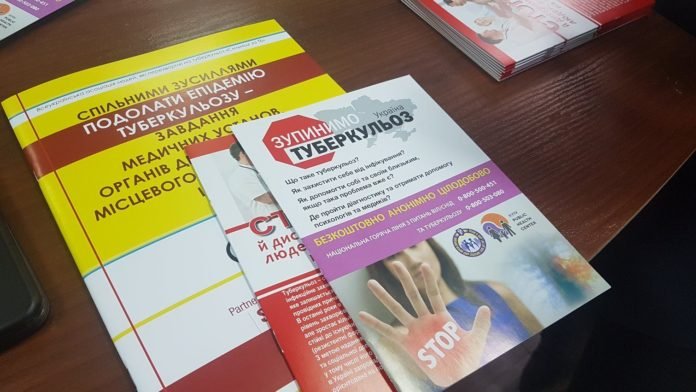In 2016-2018, “Public Movement “The Ukrainians Against Tuberculosis” Foundation implemented, with the assistance of the regional project “Strengthening health systems for effective TB and DR-TB control in Eastern Europe and Central Asia” (TB-REP project), the project “Creating a favourable sociopolitical situation for moving to the outpatient TB treatment model in Ukraine”. In this time, some positive things were achieved in TB control in Ukraine based on moving to the outpatient TB treatment model. In particular, the following was achieved in the last three years:
Active TB incidence in Ukraine in 2017 decreased by 5.5% compared to the previous year, including in the pilot oblasts: by 7.8% in Kyiv Oblast, by 9.1% in Mykolayiv Oblast, by 3.1% in Sumy Oblast and by 6.3% in Kherson Oblast. In the last years, there’s been a downward trend in TB mortality in Ukraine, with the average annual decrease rate of 10.1%. In 2017, TB mortality reduced by 13.6% to 8.2 per 100,000 people compared to 2016 (9.5 per 100,000 people). The number of TB beds in the country in 2017 decreased by 13.5% compared to 2016; outpatient treatment was received by 15.0% of patients with bacteria release, 10.0% of patients with persistent TB forms and 32.0% of patients without bacteria release. The medical and social support provided for patients with TB by representatives of the Red Cross of Ukraine, the International Charitable Foundation “Alliance for Public Health”, the All-Ukrainian Association of People who Recovered from Tuberculosis “Stronger than TB” and other non-governmental organisations reduced treatment discontinuation rate by 13.5% compared with patients who didn’t receive such support.
At the same time, having analysed the situation with multi-industry and multisectoral support for moving to the human-oriented TB treatment model, our organisation’s experts pointed to insufficient support for this important component of dealing with the TB epidemic in Ukraine at the national and regional levels. In particular, the resolution of the 67th session of the World Health Organisation (WHO) (Geneva, May 2014) says that “stopping the TB epidemic will require further extension of the scale and level of coverage with TB treatment and prevention measures, development of a system and policy for creating favourable conditions and sharing responsibility, as well as active development and use of new means of TB treatment and prevention based on targeted scientific research and innovation”, but solving the TB problem is only possible by eliminating its reasons and overcoming their negative effects, which requires a multi-industry and multisectoral approach. Although this strategy is currently the principal guiding document for the international community in dealing with TB, in Ukraine no measures have been taken at the national level to implement a multi-industry approach to TB control which the WHO calls national governments for.
To close this gap, “Public Movement “The Ukrainians Against Tuberculosis” Foundation has developed “Concept for national and regional interdepartmental and intersectoral coordination of activities in the area of dealing with the TB epidemic”. The principal novelty of this Concept is that it, for the first time since TB epidemic was recorded in Ukraine, offers to see TB control not as a system of medical measures but as a complex political, managerial, economic, social, medical, humanitarian, cultural etc. problem that can’t be effectively solved just with medical measures and sectoral medical management.
It is about developing a system of social prevention of tuberculosis, or a set of socioeconomic measures to be taken by the government to improve the conditions and way of living, labour, the environment, education etc.
Prevention is government-managed activities aimed at preventing harmful effects on human health by eliminating either a harmful factor itself or its effect on a human.
Thus, prevention of TB as a socially dangerous disease is an isolated case of the society’s general prevention activities and is an activity aimed at creating conditions that make it impossible for new cases of TB to occur and provide for doing activity aimed at decreasing the negative effects of this infectious disease on the society as a social system in general.
Using this multifaceted approach, prevention of TB spread is done by detecting, eliminating or cancelling out the reasons or conditions that help its biological agent to persist among representatives of certain social groups and among the wider population.
The state policy in the area of TB control has traditionally been implemented in Ukraine through solving a number of sectoral medical tasks. The central executive body responsible for implementing the state policy in the area of TB control is the Ministry of Health of Ukraine. But today, the problem of TB has gone beyond the healthcare sector and become a national problem due to unstoppable increase in its spread rate among Ukraine’s population. The principle of sectoral management of such a complex social matter as the TB epidemic, in particular, the purely medical approach to analysing the epidemiological indicators, hinders timely forecasting of the prospects for TB epidemic development and preparation of an appropriate plan for national multi-industry response to its challenges, as a result of which the TB epidemic not only remains a great threat to the lives and health of our people, but, on a larger scale, also gives grounds for regarding this situation as a major threat to Ukraine’s national security, is an obstacle on Ukraine’s way to European integration. That’s why the state policy for TB control can’t be successful if it’s only aimed at dealing with the TB challenges with medical means, without providing for a multifaceted approach that will help to eliminate the fundamental socioeconomic reasons and consequences of the spread of the TB epidemic in Ukraine.
Ukraine’s traditional instrument of implementing the state policy in the area of TB control is medical and social national and local targeted programmes aimed exclusively at organising the provision of TB care for people. In essence, instead of eliminating the reasons underlying the epidemic, these programmes are intended to deal with its consequences, so systemic revision of the approaches to their development and the ways of implementation in particular and to the state policy for TB control in general is high on the agenda.
Due to lack of clear awareness about the level of the spread of the epidemic, financing of TB measures has traditionally been channelled for the most part to dealing with the consequences of the epidemic rather than its prevention, which, in turn, has resulted in growing rate of the spread of the epidemic and low efficiency of use of money allocated to fighting it.
Tuberculosis, as a socially dangerous problem, by default has factors and consequences that are present in all or most of the areas of Ukrainian people’s life.
In these circumstances, in the present-day historic and socioeconomic conditions, of special significance is involvement of various central and regional government bodies and local self-government bodies in dealing with the TB problem in Ukraine, defining and formalising their competencies and functions in general in order to ensure participation of various relevant central and local government bodies in the development and implementation of the state policy for TB control; to do TB prevention in the targeted groups of the population, first of all, the TB high-risk groups, through providing information and appropriate social services for them; to assist in organising and carrying out obligatory annual preventive examinations for the purpose of timely detecting new cases of TB in the targeted groups of the population, first of all, the TB high-risk groups; to strengthen the level of societal response to TB-related challenges through increasing the political commitment and responsibility of the government and enhancing social mobilisation for dealing with the TB epidemic at the community level; to assess and forecast the situation with TB in the context of the following main areas of the development and implementation of the state policy for TB control: calculating estimated sizes of groups with various TB risk levels; forecasting trends in the development of the TB epidemic; assessing the scale and consequences of the TB epidemic in case effective preventive measures aren’t taken; effective planning, implementation and assessment of prevention programmes etc.
Concurrently, important socioeconomic reforms should be implemented aimed at overcoming poverty; reducing unemployment; ensuring state control over inbound migration; dealing with homelessness and unattendedness; ensuring appropriate living conditions, quality of life and social guarantees; reforming the healthcare system; reforming, re-organising and restructuring the TB service to improve it.
A set of medical and social measures carried out simultaneously to deal with the TB epidemic should include social prevention among the risk groups and the general population, including provision of information, provision of explanations, education etc.; medical prevention, in particular, vaccination, chest radiography, preventive examinations etc.; determining, classifying and establishing credible sizes of the TB risk groups (higher, quite high and relatively low risk levels) and organising and doing prevention work with them on a permanent basis; active detection of new cases of the disease; inpatient and outpatient treatment of people with TB; social support for people with TB; social and medical rehabilitation of people who suffered from TB; protection of people’s rights and interests in the context of the TB epidemic and so on.
What should be done to solve the problem? According to the requirements of the existing legislation (Article 2 of the Law of Ukraine “On State Targeted Programmes”), the state policy for TB control must be aimed at ensuring concentration of financial, material and technical and other resources, manufacturing, scientific and technical potential, as well as coordination of the activities of central and local executive bodies, enterprises, institutions and organisations for the said problem to be solved on a nationwide scale. The following is proposed to achieve this.
- Re-formatting of the state management in the area of TB control.
Ukrainian governance scientists believe that given the special social danger of TB, the state policy in this area should deal with the task of achieving interaction and coordination of the efforts of various government bodies in Ukraine aimed at fighting TB in order to help eliminate the fundamental socioeconomic reasons for the spread of the TB epidemic, i.e. the cornerstone of the modern policy for TB control should be primary, or social prevention of TB in which a wide circle of executive government bodies should be involved, namely: the Ministry of Social Policy, the Ministry of Education and Science, the Defence Ministry, the Ministry of Internal Affairs, the Ministry of Youth and Sports, the Ministry of Culture, the Ministry of Ecology and Natural Resources, the Ministry of Infrastructure, the Ministry of Regional Development, Construction and Housing and Communal Services, the Ministry of Information Policy, the State Committee for Television and Radio Broadcasting, the Ministry of Justice, the State Migration Service, the State Emergency Service, the State Service for Disabled People and Veterans, the State Veterinary and Phytosanitary Service, the State Labour Service, their regional divisions (if exist) and representatives of the civil society (a list of possible activities by the latter is attached hereto).
The areas of responsibility must be clearly defined of the various central executive bodies for ensuring the epidemiological well-being of the population and dealing with TB. In particular, they’ll concern four main task areas.
The first one is working with the TB risk groups that have priority for a given executive government body:
– calculating estimated sizes of various-level TB risk groups that are targeted ones for these government bodies;
– participation in measures aimed at TB prevention and detection in the targeted population groups, first of all, the TB high-risk groups, by way of providing information and appropriate social services.
Socially disadapted and socially unprotected population groups account for 65.0% of new cases of TB. These are complex groups that are sometimes closed and hardly accessible to healthcare bodies (for example, homeless people, incoming migrants, Roma people). A complete list of such risk groups should be drawn up, properly described and formally included in the duties and responsibilities of certain executive government bodies on the national and regional levels, the procedure and peculiarities should be determined of TB prevention, detection and treatment in each of these groups.
Each central executive body, apart from performing general state functions, should take charge of certain specific population groups that can be TB risk ones, maintain contact and work with them in the determined area.
Of special significance here are new TB risk groups that came to exist in Ukraine as a result of the annexation of the Crimea and the military action in the Donbass. This problem was emphasized by Dr Elliot Perlman, chairman of the Board of the International Institute for HIV/AIDS and TB-related Problems, during the roundtable on the topic “Advocacies aimed at overcoming TB: the way to fighting TB in the Joint Forces Operation (JFO) zone (November 2016 to the present)” who said that during the military conflict in Eastern Ukraine, a new critical TB group appeared – military servicemen involved in the military action waged as part of the joint forces operation.
The second one is carrying out by executive government bodies of primary (socioeconomic) TB prevention measures, that is, within their powers, activities aimed at eliminating or neutralising the reasons for TB and the conditions engendering it.
– forecasting trends in the development of the TB epidemic within the defined powers;
– assessing the scale and consequences of the TB epidemic in case no effective preventive measures are taken;
– planning, implementing and assessing prevention programmes etc.
The third one is providing regulatory support for participation of various interested executive government bodies in carrying out tasks determined by the state policy for TB control, their participation in development and implementation of state measures and programmes in this area.
The fourth one is developing, discussing and approving by a government document (regional documents) of multifaceted strategies (plans) for interdepartmental and intersectoral TB control activities; holding a parliamentary hearing on the topic “State policy for TB control: problems and ways of reforming” (the mechanism for the state policy is set out in the annex hereto).
To achieve these tasks, first of all, use and implementation of the effective requirements of the existing legislation should be ensured that empower various central and regional government bodies to participate (or point to this possibility) in the implementation of the state policy for TB control and coordinate it.
Thereafter, if such obligations don’t exist or are restricted, it’s necessary to make amendments to the existing legal and regulatory framework, including by way of developing and approving changes and additions to provisions on central and local executive government bodies regarding their competences in the area of TB epidemic control.
Based on the aforementioned Concept, the following has been developed:
– Roadmaps for ensuring successful TB control based on a multifaceted inter-industry and intersectoral approach in the context of moving to patient-oriented TB treatment models (specifically for each pilot oblasts);
– Strategies for inter-industry and intersectoral TB control activities in Sumy, Kherson and Kyiv oblasts.
The roadmaps were developed based on international TB control recommendations, Ukraine’s existing legislation in the area of TB control, “Tuberculosis” Unified clinical protocol for primary, secondary (specialised) and tertiary (highly specialised) medical care for adults”, the provisions on the oblast government bodies of Sumy, Kherson and Kyiv oblasts and scientific and popular-science TB-related literature.
The Roadmap and the Strategy will enable all interested oblast government bodies, other parties and persons to find their place in the nationwide cause of overcoming the TB burden in Ukraine, will help certain TB high-risk population groups to take in the situation with TB in Ukraine and get to know how to guard themselves against the disease, and will enable those who have TB to become aware of their rights and obligations and the basic rules of conduct on the way “from cough to recovery”.
On 1 November 2018, a meeting of Sumy Oblast Coordination Council on TB and HIV/AIDS Control took place where the issue was discussed of approving the Roadmap for ensuring successful TB control based on a multifaceted multi-industry and multisectoral approach in the context of moving to patient-oriented TB treatment models in Sumy Oblast. The Coordination Council took the decision to approve the said document and ordered rayon and town councils on TB and HIV/AIDS control to approve the respective Roadmaps before 31 December 2018.
On 4 December 2018, a meeting of Kherson Oblast Council on TB and HIV/AIDS Control took place. Based on the results of the meeting, Kherson Oblast Council on TB and HIV/AIDS Control recommended that the Department of Health of the Oblast State Administration develop an Oblast plan for inter-industry and intersectoral TB control activities in Kherson Oblast based on the multifaceted strategy for inter-industry and intersectoral TB control activities developed by the Charitable Organisation “The Ukrainians Against TB”, and approve it.
Also, the Council took the decision to approve the Roadmap for ensuring successful TB control to be used by TB/HIV councils.
Thus, introduction of the WHO-recommended multi-industry and multisectoral approach to dealing with the TB epidemic started in Ukraine for the first time.
Charitable Organisation “Public Movement “The Ukrainians Against Tuberculosis” Foundation






